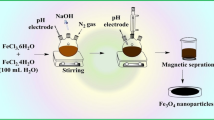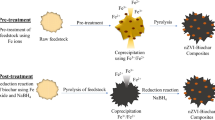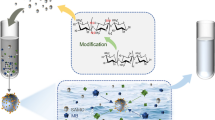Abstract
Due to the severity of arsenic contamination of soil and water resources around the world, finding new adsorbents for arsenic removal from the water is of high importance. The present study investigates the possible use and effectiveness of starch-stabilized Fe/Cu nanoparticles for adsorption of arsenic from aqueous solutions. First, Fe/Cu nanoparticles at various starch concentrations of 0, 0.02, 0.04 and 0.06 wt% were synthesized and characterized by X-ray diffraction, transmission electron microscopy and zeta potential/particle size analyzer. Then 0.04 wt% stabilized Fe/Cu nanoparticles were tested for the sorption of As(III) and As(V) from synthetic arsenic-contaminated water. To have an understanding about the arsenic adsorption mechanism of nanoparticles, X-ray photoelectron spectroscopy (XPS) was performed before and after adsorption. The results showed that starch provides nanoparticles with a neutral surface and stabilization of nanoparticles is possible with 0.04 wt% or higher concentrations of starch. For 0.04 wt% starch-stabilized Fe/Cu nanoparticles, the adsorption isotherms fit well within the Langmuir equation, with maximum sorption capacities of 90.1 mg/g for As(III) and 126.58 mg/g for As(V) at a pH of 7.0 from the aqueous arsenic solutions. Examining the XPS spectra of nanoparticles before and after adsorption showed that arsenic adsorption by this nanoparticle can be due to the formation of inner-sphere arsenic complexes on the particle surface, and the surface oxygen-containing functional groups involved in adsorption. The high sorption capacity suggests the potential for applying starch-stabilized Fe/Cu nanoparticles to the contaminated waters for removal of arsenic.












Similar content being viewed by others
References
Ahamed S, Kumar Sengupta M, Mukherjee A, Amir Hossain M, Das B, Nayak B, Pal A, Chandra Mukherjee S, Pati S, Nath Dutta R, Chatterjee G, Mukherjee A, Srivastava R, Chakraborti D (2006) Arsenic groundwater contamination and its health effects in the state of Uttar Pradesh (UP) in upper and middle Ganga plain, India: a severe danger. Sci Total Environ 370:310–322
Azcue JM, Nriagu JO (1994) Arsenic: historical perspectives. In: Nriagu JO (ed) Arsenic in the environment, part I: cycling and characterization. Wiley, New York, pp 1–16
Chakraborti D, Mukherjee SC, Pati S, Sengupta MK, Rahman MM, Chowdhury UK, Lodh D, Chanda CR, Chakraborti AK, Basu GK (2003) Arsenic groundwater contamination in Middle Ganga Plain, Bihar, India: a future danger? Environ Health Perspect 111(9):1194–1201
Choong T, Chuah TG, Robiah Y, Gregory Koay FL, Azni I (2007) Arsenic toxicity, health hazards and removal techniques from water: an overview. Desalination 217:139–166
Chowdhury SR, Yanful EK, Pratt AR (2011) Arsenic removal from aqueous solutions by mixed magnetite–maghemite nanoparticles. Environ Earth Sci 64(2):411–423
Ding M, De Jong BHWS, Roosendaal SJ, Vredenberg A (2000) XPS studies on the electronic structure of bonding between solid and solutes: adsorption of arsenate, chromate, phosphate, Pb21, and Zn21 ions on amorphous black ferric oxyhydroxide. Geochim Cosmochim Acta 64(7):1209–1219
Dixit S, Hering JG (2003) Comparison of arsenic(V) and arsenic(III) sorption onto iron oxide minerals: implications for arsenic mobility. Environ Sci Technol 37:4182–4189
EPA-542-R-02-004 (2002) Arsenic treatment technologies for soil, waste, and water, solid waste and emergency response, (5102G). www.epa.gov/tioclu-in.org/arsenic
Freundlich HMF (1906) Over the adsorption in solution. J Phys Chem 57:385–471
Goffinet CJ, Mason SE (2012) Comparative DFT study of inner-sphere As(III) complexes on hydrated a-Fe2O3(0001) surface models. J Environ Monit 14:1860–1871
Grieger KD, Fjordbøge A, Hartmann NB, Eriksson E, Bjerg PL, Baun A (2010) Environmental benefits and risks of zero-valent iron nanoparticles (nZVI) for in situ remediation: risk mitigation or trade-off? J Contam Hydrol 118(3):165–183
He F, Zhao D (2005) Preparation and characterization of a new class of starch-stabilized bimetallic nanoparticles for degradation of chlorinated hydrocarbons in water. Environ Sci Technol 39:3314–3320
IPCS (2001) Arsenic and arsenic compounds, 2nd ed. Geneva. World Health Organization, International Program on Chemical Safety (Environmental Health Criteria 224; http://whqlibdoc.who.int/ehc/WHO_EHC_224.pdf)
Khin MM, Sreekumaran Nair A, Jagadeesh Babu V, Murugan R, Ramakrishna S (2012) A review on nanomaterials for environmental remediation. Energy Environ Sci 5:8075–8109
Kubicki JD, Kwonk D, Paul W, Sparks DL (2007) Surface complex structures modelled with quantum chemical calculations: carbonate, phosphate, sulphate, arsenate and arsenite. Eur J Soil Sci 58:932–944
Kuo CH, Chen CH, Huang MH (2007) Seed-mediated synthesis of monodispersed Cu2O nanocubes with five different size ranges from 40 to 420 nm. Adv Funct Mater 17:3773–3780
Liang QQ, Zhao DY, Qian TW, Freeland K, Feng YC (2012) Effects of stabilizers and water chemistry on arsenate sorption by polysaccharide-stabilized magnetite nanoparticles. Ind Eng Chem Res 51:2407–2418
Lim M, Han GC, Ahn JW, You KS, Kim HS (2009) Leachability of arsenic and heavy metals from mine tailings of abandoned metal mines. Int J Environ Res Public Health 6(11):2865–2879
Liu CH, Chuang YH, Chen TY, Tian Y, Li H, Wang MK, Zhang W (2015) Mechanism of arsenic adsorption on magnetite nanoparticles from water: thermodynamic and spectroscopic studies. Environ Sci Technol 49(13):7726–7734
Maharjan M, Watanabe C, Aktar Ahmad SK, Ohtsuka R (2005) Short report: arsenic contamination in drinking water and skin manifestations in lowland Nepal: the first community-based survey. Am J Trop Med Hyg 73(2):477–479
Manning BA, Fendorf SE, Goldberg S (1998) Surface structures and stability of Arsenic(III) on goethite: spectroscopic evidence for inner-sphere complexes. Environ Sci Technol 32:2383–2388
Morales-Luckie RA, Sanchez-Mendieta V, Arenas-Alatorre JA, López-Castañares R, Perez-Mazariego JL, Marquina-Fabrega V, Wayne Gómez R (2008) One-step aqueous synthesis of stoichiometric Fe–Cu nanoalloy. Mater Lett 62:4195–4197
O’Carroll D, Sleep B, Krol M, Boparai H, Kocur C (2013) Nanoscale zero valent iron and bimetallic particles for contaminated site remediation. Adv Water Resour 51:104–122
Phenrat T, Saleh N, Sirk K, Kim HJ, Tilton RD, Lowry GV (2008) Stabilization of aqueous nanoscale zerovalent iron dispersions by anionic polyelectrolytes: adsorbed anionic polyelectrolyte layer properties and their effect on aggregation and sedimentation. J Nanopart Res 10(5):795–814
Qian Y, Ye F, Xu J, Le ZG (2012) Synthesis of cuprous oxide (Cu2O) nanoparticles/graphene composite with an excellent electrocatalytic activity towards glucose. Int J Electrochem Sci 7:10063–10073
Raveendran P, Fu J, Wallen SL (2003) Complete “Green” synthesis and stabilization of metal nanoparticles. J Am Chem Soc 125:13940–13941
Saleh TA (2015) Mercury sorption by silica/carbon nanotubes and silica/activated carbon: a comparison study. J Water Supply Res Technol AQUA 64(8):892–903
Saleh TA (2016) Nanocomposite of carbon nanotubes/silica nanoparticles and their use for adsorption of Pb(II): from surface properties to sorption mechanism. Desalination Water Treat 57(23):10730–10744
Saleh TA, Sarı A, Tuzen M (2017) Effective adsorption of antimony (III) from aqueous solutions by polyamide-graphene composite as a novel adsorbent. Chem Eng J 307:230–238
Sparks DL (1989) Kinetics of Soil Chemical Processes. Academic Press, New York
Shih MC (2005) An overview of arsenic removal by pressure driven membrane processes. Desalination 172:85–97
Sirk KM, Saleh NB, Phenart T et al (2009) Effect of adsorbed polyelectrolytes on nanoscale zerovalent iron particle attachment to soil surface models. Environ Sci Technol 43:3803–3808
Tsibranska I, Hristova E (2011) Comparison of different kinetic models for adsorption of heavy metals onto activated carbon from apricot stones. Bulg Chem Commun 43(370):377
Wang S, Sun H, Ang HM, Tadé MO (2013) Adsorptive remediation of environmental pollutants using novel graphene-based nanomaterials. Chem Eng J 226:336–347
Wang Y, Liu W, Wanga T, Ni J (2015) Arsenate adsorption onto Fe-TNTs prepared by a novel water–ethanol hydrothermal method: mechanism and synergistic effect. J Colloid Interface Sci 440:253–262
Welch AH, Lico MS, Hughes JL (1988) Arsenic in ground water of the Western United States. Groundwater 26(3):333–347
Zhang W (2003) Nanoscale iron particles for environmental remediation: an overview. J Nanopart Res 5:323–332
Zhang Y, Yang M, Dou X-M, He H, Wang D-S (2005) Arsenate adsorption on an Fe–Ce bimetal oxide adsorbent: role of surface properties. Environ Sci Technol 39:7246–7253
Zhang S, Li X, Chen JP (2010) An XPS study for mechanisms of arsenate adsorption onto a magnetite-doped activated carbon fiber. J Colloid Interface Sci 343:232–238
Acknowledgements
The authors gratefully acknowledge the financial support of Concordia University and the Natural Science and Engineering Research Council for the research.
Author information
Authors and Affiliations
Corresponding author
Rights and permissions
About this article
Cite this article
Babaee, Y., Mulligan, C.N. & Rahaman, M.S. Stabilization of Fe/Cu nanoparticles by starch and efficiency of arsenic adsorption from aqueous solutions. Environ Earth Sci 76, 650 (2017). https://doi.org/10.1007/s12665-017-6992-z
Received:
Accepted:
Published:
DOI: https://doi.org/10.1007/s12665-017-6992-z




